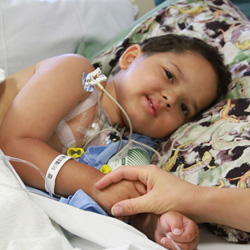About Germ Cell Tumors
The term "germ cell" comes from the term "geminate," which means giving life. In humans, germ cells produce specialized cells needed for reproduction: sperm cells in boys and egg cells in girls. Germ cell cancer is a rare tumor that affects children, teens, and adults. More than 900 children and adolescents are diagnosed with germ cell tumors in the U.S. each year, comprising about 5% of all childhood cancers. Germ cell tumors most commonly appear in the testes for boys and the ovaries for girls. However, these tumors can also arise in the abdomen and pelvis, the mediastinum (the part of the chest between the breastplate and the spinal column), and the brain.
There are two types of germ cell tumors: malignant (life-threatening) or benign (not life-threatening). Malignant germ cell tumors include several types of cancer, such as immature teratoma, yolk sac tumor, embryonal carcinoma, and choriocarcinoma. They can impact the testes or ovaries and can spread to other parts of the body. Benign germ cell tumors include certain kinds of teratomas, a type of tumor that may contain several different types of tissue. Although these benign tumors are not as difficult to treat as malignant tumors, they can cause problems because of their size.
Signs and Symptoms of Germ Cell Tumors
The signs and symptoms of germ cell tumors differ depending on where the tumors begin:
- Testicular germ cell tumors commonly begin as a painless mass in the scrotum (the skin that holds the testicles). Parents are most likely to notice the development of these tumors in small boys. For teenagers, testicular tumors may be more difficult to detect if parents and teens are uncomfortable discussing such intimate matters.
- Ovarian and abdominal tumors often present with symptoms like abdominal pain or constipation. As a tumor gets bigger, it may become evident as an abdominal mass.
- Mediastinal tumors form in the part of the chest between the breastbone and spinal column and can grow without symptoms until they become quite large. Once large, they can cause chest pain, shortness of breath, and wheezing.
- Sacrococcygeal teratomas are found as a mass that protrudes around the anus and are usually diagnosed in newborns and removed. However, these tumors can also be internal, in which case they may grow unnoticed for many months and may become malignant. Internal tumors may cause constipation, urinary retention, and pain.



